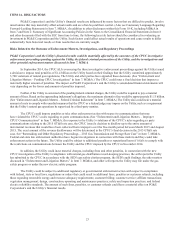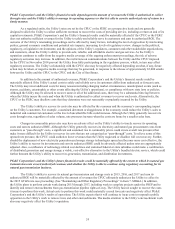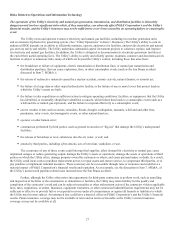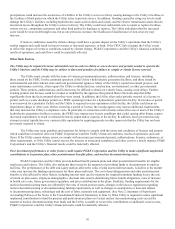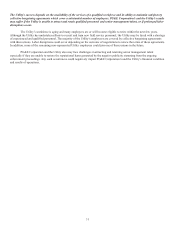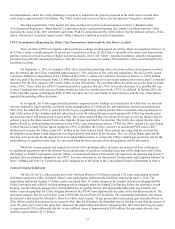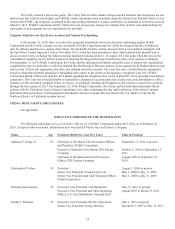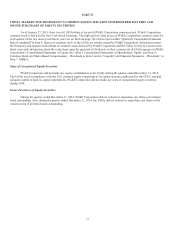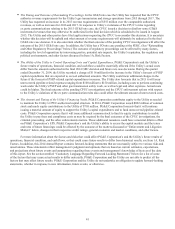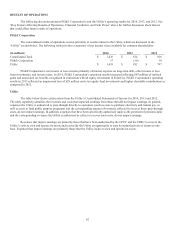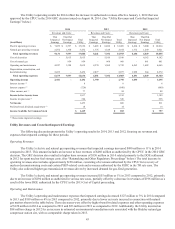PG&E 2014 Annual Report Download - page 41
Download and view the complete annual report
Please find page 41 of the 2014 PG&E annual report below. You can navigate through the pages in the report by either clicking on the pages listed below, or by using the keyword search tool below to find specific information within the annual report.33
recommendations, and if the Utility ultimately is required to implement the projects proposed in the draft report, it could incur
costs of up to approximately $30 million. The Utility would seek to recover these costs through rates charged to customers.
The final requirements of the federal and state cooling water policies (discussed above in Item 1. Business under
“Environmental Regulation – Water Quality”) could affect future negotiations between the Central Coast Board and the Utility
regarding the status of the 2003 settlement agreement. PG&E Corporation and the Utility believe that the ultimate outcome of this
matter will not have a material impact on the Utility’s financial condition or results of operations.
CPUC Investigations Regarding the Utility’s Gas Transmission System and the San Bruno Accident
There are three CPUC investigative enforcement proceedings pending against the Utility. These investigations relate to (1)
the Utility’s safety recordkeeping for its natural gas transmission system, (2) the Utility’s operation of its natural gas transmission
pipeline system in or near locations of higher population density, and (3) the Utility’s pipeline installation, integrity management,
recordkeeping and other operational practices, and other events or courses of conduct, that could have led to or contributed to the
San Bruno accident.
On September 2, 2014, the assigned CPUC ALJs issued their presiding officer decisions in these investigations in which
they determined that the Utility committed approximately 3,700 violations of law, rules and regulations. The ALJs jointly issued
a decision calling for total penalties of $1.4 billion on the Utility to address all violations, allocated as follows: (1) $950 million
fine to be paid to the State General Fund, (2) $400 million refund to ratepayers of previously authorized revenues, and (3) remedial
measures that the ALJs estimate will cost the Utility at least $50 million. The presiding officer decisions are not the final decisions
of the CPUC. Three of the five CPUC Commissioners have requested that the CPUC review the decisions. It is possible that one
or more Commissioners will issue an alternate penalty decision for consideration by the CPUC. In addition, in October 2014, the
Utility and other parties, including the SED, TURN, the ORA, the City and County of San Francisco, and the City of San Bruno
appealed the presiding officer decisions.
In its appeals, the Utility argued that the penalties imposed and the findings and conclusions on which they are based do
not meet applicable legal standards, are based on the misapplication of California law and regulations, and are unconstitutional.
The Utility has asked the CPUC to order the Utility to pay a significantly reduced penalty that is reasonable and proportionate in
light of the nature of the violations and that takes into account the substantial unrecovered amounts the Utility has already spent
and forecasts that it will spend on gas system safety. The Utility requested that it be allowed 180 days to raise the funds it may be
ordered to pay to the State General Fund rather than the 40 days specified in the decision. The Utility also argued that the entire
penalty should go toward funding investments in the Utility’s gas transmission system. TURN, the ORA, and the City and County
of San Francisco jointly filed an appeal urging the CPUC to disallow the Utility’s recovery of remaining PSEP costs of $877
million and to require the Utility to pay $473 million to the State General Fund. These parties also argue that the record in the
investigative proceedings would support an even larger penalty than stated in the decision. The City of San Bruno appealed the
rejection of its proposals for the appointment of an independent monitor to oversee the Utility’s natural gas operations and for the
establishment of a pipeline safety trust. It is uncertain when the final outcome of the investigations will be determined.
While the various appeals and requests for review of the presiding officer decisions are unresolved there continues to
be significant uncertainty about the ultimate forms and amounts of penalties (including fines) that will be imposed on the Utility.
The impact on PG&E Corporation’s and the Utility’s Consolidated Financial Statements will depend on the amounts and forms of
penalties that are ultimately adopted by the CPUC. For more information, see discussions “Enforcement and Litigation Matters” in
Item 7. MD&A and Note 14: Commitments and Contingencies of the Notes to the Consolidated Financial Statements in Item 8.
Federal Criminal Indictment
On July 29, 2014, a federal grand jury in the Northern District of California returned a 28-count superseding criminal
indictment against the Utility in federal district court replacing the indictment that had been returned on April 1, 2014. The
superseding indictment charges 27 felony counts (increased from 12 counts charged in the original indictment) alleging that the
Utility knowingly and willfully violated minimum safety standards under the Natural Gas Pipeline Safety Act relating to record
keeping, pipeline integrity management, and identification of pipeline threats. The superseding indictment also includes one
felony count charging that the Utility illegally obstructed the NTSB’s investigation into the cause of the San Bruno accident. The
maximum statutory fine for each felony count is $500,000, for total fines of $14 million. The superseding indictment also alleges
an alternative fine under the Alternative Fines Act which states, in part: “If any person derives pecuniary gain from the offense, or
if the offense results in pecuniary loss to a person other than the defendant, the defendant may be fined not more than the greater of
twice the gross gain or twice the gross loss.” Based on the superseding indictment’s allegations that the Utility derived gross gains
of approximately $281 million and that the victims suffered losses of approximately $565 million, the maximum alternate fine
would be approximately $1.13 billion.


